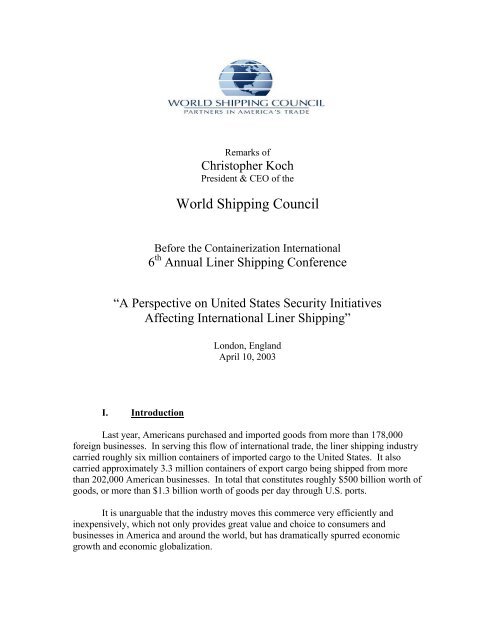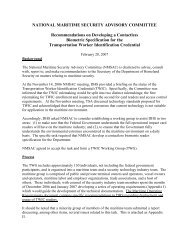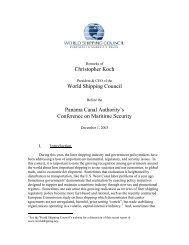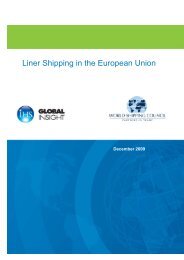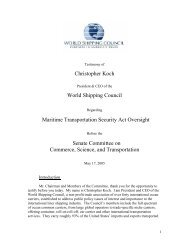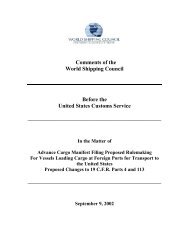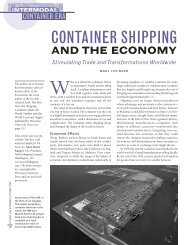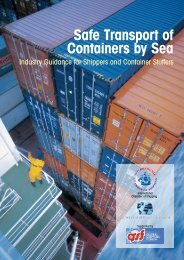DRAFT Speech - World Shipping Council
DRAFT Speech - World Shipping Council
DRAFT Speech - World Shipping Council
Create successful ePaper yourself
Turn your PDF publications into a flip-book with our unique Google optimized e-Paper software.
Remarks ofChristopher KochPresident & CEO of the<strong>World</strong> <strong>Shipping</strong> <strong>Council</strong>Before the Containerization International6 th Annual Liner <strong>Shipping</strong> Conference“A Perspective on United States Security InitiativesAffecting International Liner <strong>Shipping</strong>”London, EnglandApril 10, 2003I. IntroductionLast year, Americans purchased and imported goods from more than 178,000foreign businesses. In serving this flow of international trade, the liner shipping industrycarried roughly six million containers of imported cargo to the United States. It alsocarried approximately 3.3 million containers of export cargo being shipped from morethan 202,000 American businesses. In total that constitutes roughly $500 billion worth ofgoods, or more than $1.3 billion worth of goods per day through U.S. ports.It is unarguable that the industry moves this commerce very efficiently andinexpensively, which not only provides great value and choice to consumers andbusinesses in America and around the world, but has dramatically spurred economicgrowth and economic globalization.
The principal issue and challenge facing the industry, its customers, and thegovernments of the international trading community is how to enhance the security ofthis commercial process in a way that both prevents the risk of terrorist threats frombeing realized, and enables trade to flow efficiently and reliably.The challenge is indeed substantial. But so are the efforts of government andindustry. There have been, at times, differences that the industry has expressed regardingcertain regulatory proposals or how certain security initiatives may have beenimplemented. The liner shipping industry, however, has fully and consistently supportedthe core strategy of the U.S. government of –• Developing new international security regimes at the InternationalMaritime Organization covering ships and port facilities, and of• Building cooperative agreements with its trading partners that facilitate(1) pre-loading cargo manifest review, (2) notices not to load cargo thatrequires further review, and (3) the establishment of cargo inspectioncapabilities at ports of loading allowing security officials to inspect anyhigh risk container for security reasons.Today, I would like to discuss the various pieces of these efforts and offer someperspectives on future directions and efforts.Before discussing the security initiatives and their substance, it might be helpfulto consider some of the political considerations that surround these issues in the UnitedStates.Members of the Democratic Party in the United States have been consistentlycriticizing the Bush Administration for not doing enough to protect the nation’s homelandsecurity. Some of this criticism is that not enough money is being spent to addressvarious homeland security issues. Some of the criticism has involved the government’streatment of containerized shipping. On February 14, the Democratic leaders of theSenate and House of Representatives sent a joint letter to the President calling on theAdministration to “ensure that 100 percent of cargo containers are inspected beforeentering the United States”. Shortly thereafter, a Democratic Member of the House ofRepresentatives introduced a bill (H.R. 1010) that calls for 100 percent of all containersand trailers to be inspected by U.S. Customs in the nation of export (affecting trucking,rail, aviation, and ocean shipping), and for the U.S. Coast Guard to board all incomingvessels outside 200 miles to ensure that all containers were secure. On March 29 th , theDemocrats’ weekly radio address criticized Customs’ level of container inspections, andstated that it was inadequate. Whether these proposals will be pushed legislativelyremains to be seen, but they do provide a clear contrast with the approach of U.S.Customs Commissioner Bonner and Homeland Security Under Secretary Hutchison whostate that the objective should not be to inspect 100% of all containers, but to inspect100% of all container that raise security issues.2
Maritime security is, by no means, however, simply a matter of partisan politics.Bipartisan legislation was passed at the end of the last Congress in December – theMaritime Transportation Security Act. Senate hearings were held last month on the issueof container security, and the committee’s Republican chairwoman stated after thehearing that “I give [Customs] good marks for starting these initiatives, but we need tostep up the pace," because "I believe this is our single greatest vulnerability." It is clearthat the Administration, for both security and political reasons, must be able todemonstrate that tangible, meaningful programs are established to address supply chainvulnerability.A host of initiatives from the Administration have been undertaken to addressdifferent aspects of how to provide enhanced security. A comprehensive examination ofship security, marine terminal and port security, personnel security, and cargo securityhas been underway and continues. The leadership and missions of the Customs Service,the Coast Guard, the Transportation Security Administration, and the Immigration andNaturalization Service have been combined in the new Department of HomelandSecurity. In short, 2003 has begun with a great deal of activity in the maritime securityarena, and these initiatives will continue through the year. As a result, it will be veryimportant for all affected sectors to be aware of what is being considered and what isbeing implemented. These issues are a highly relevant part of ContainerizationInternational’s 6 th Annual Liner <strong>Shipping</strong> Conference.II.Specific Security InitiativesThis morning I would like to address twelve of the most substantial maritimesecurity initiatives that the U.S, government has been pursuing. The liner shippingindustry has generally supported these government initiatives. It has worked to makethem effective, while at the same time ensuring that they allow for the continued,efficient movement of commerce. The <strong>Council</strong> and its Member lines have supported theU.S. Customs Service’s 24-hour rule and supported the Container Security Initiative.Every single Member company of the <strong>Council</strong> has joined the Customs’ Trade PartnershipAgainst Terrorism. The <strong>Council</strong> has supported the U.S. Coast Guard and othergovernments’ efforts that produced new international security rules for ships and portfacilities. The industry will continue to support these initiatives and the strategies behindthem.A. Cargo and Supply Chain Security1. Container Security Initiative (CSI)The CSI program is a set of government-to-government agreements that theUnited States Customs Service (now the Bureau of Customs and Border Protection) hasentered into to enhance the security of containerized shipments of cargo. In order to beeligible for participation in CSI, countries and their customs administrations must:• Have regular, direct and substantial container traffic to the U.S.3
• Have legal authority to collect information about and inspect export, transit andtransshipped cargoes from their territories;• Have, or be in the process of obtaining, non-intrusive inspection (NII) equipmentand radiation inspection equipment for containerized cargoes; and• Commit to share data for the pre-screening of cargoes, and have the capability toassess, analyze and process such data.Once a customs administration has met these criteria, it or the responsible ministrysigns a Declaration of Principle (DOP) with U.S. Customs. In addition to the U.S.-Canada agreement of February 2002 covering Vancouver, Halifax and Montreal (andSeattle and Newark in the U.S.), CSI DOPs have been signed covering the following 21ports: Algeciras, Spain; Antwerp, Belgium; Bremerhaven, Germany, Felixstowe, U.K.;Genoa, Italy; Gothenburg, Sweden; Hamburg, Germany; Hong Kong; Kobe, Japan; LaSpezia, Italy; Le Havre, France; Nagoya, Japan; Port Klang, Malaysia; Pusan, SouthKorea; Rotterdam, The Netherlands; Shanghai, China; Singapore; Tanjun Pelepas,Malaysia; Tokyo, Japan; Yantian, China; Yokohama, Japan. 1Some time after the signing of the DOP, the declaration is executed througha pilot program of an expected duration of 6 months. To initiate the pilot program,Customs sends a team of officers to the foreign CSI port to conduct site assessments,arrange for the practical cooperation and data sharing with the local customsadministration, install, cargo information systems, computers and software etc.While the needs of each port will be addressed individually -- and be reflected inthe sizes of the pilot teams -- these teams are typically made up of 5 officers (threeinspectors, a research analyst and a senior Customs official acting as team leader).When the Customs pilot program team has been deployed and is installed in theforeign CSI port, the port officially becomes “CSI operational”. As of mid-March, thefollowing CSI ports are “operational” (listed in the order in which they became so): Thethree Canadian ports, Rotterdam, Le Havre, Antwerp, Hamburg, Bremerhaven and, as ofmid-March, the first Asian port - Singapore.Considerable progress has been made in establishing CSI agreements, and moreprogress is imminent. A possible CSI agreement with the European Union would expandthe cooperative initiative and its security enhancements to even more European ports.These initiatives by U.S. Customs and their counterparts are an essential, logical coreelement of enhanced container security.There are several important challenges that the CSI faces. First, the progress andestablishment of these agreements is, in diplomatic time frames, rapid and successful. Itis important, however, for the governments involved to show that CSI agreements aremore than paper documents, but are real initiatives with adequate staffing levels,adequate levels of container inspection equipment, appropriate levels of container1 These ports handle approximately 60 percent of the cargo that is transported to the United States.4
inspection, and at least some non-classified discussion of whether it is producingsuccessful results. Unless this is done, questions about the adequacy of container securitywill continue unabated. Unless this is done, the security infrastructure to keep tradeflowing in the event of a terrorist incident in this sector of the economy may beinsufficient.The second challenge facing CSI is its expansion to smaller ports. Customsappropriately has focused on the largest volume ports to begin the program. But theprogram logically should be expanded to other ports. For example, no port in Africa orLatin America is yet a CSI port.2. The 24-Hour RuleAn essential element of the CSI cargo security strategy is providing the governmentwith cargo shipment information for screening before vessel loading. Starting in earlyFebruary, the liner shipping industry and its customers have expended substantial time,energy and money in changing their systems and business processes to comply with theU.S. government’s rule requiring cargo information to be filed 24 hours before vesselloading. It has been expensive and difficult. But it is a clear and necessary portion of thegovernment’s strategy, and its early implementation generally has been handled with careand consideration by Customs.Clearly there are both current issues that need to be addressed and future issues thatwill need to be addressed under this rule. Based on our experience to date, Customs hasshown both a willingness and a professional attitude in trying to address such issues withthe industry. One current issue under review is how to address the operational difficultiesthat some automated NVOCCs have experienced in moving their cargo efficientlythrough U.S. ports of discharge. The <strong>Council</strong> and its Members are working withNVOCC representatives and Customs in trying to address these issues, and we areoptimistic that progress can be made soon.Other issues will arise as Customs inevitably “ramps up” its enforcement of theadvance information filing. Initially, Customs has focused on the adequacy of cargodescriptions. Last Friday, Commissioner Bonner announced that the next step will be forthe agency to focus on consignee information, on timeliness of the information filing, andon a continued focus on proper cargo descriptions. As the year progresses, it is likelyCustoms will work to improve the information it receives in other respects. A continued,constructive dialogue between industry and Customs will be necessary because the issuesthat arise can be complex, and clear communication and understanding of requirementswill be essential. For example, the issue of who should be listed as the “shipper” of acontainer of consolidated cargo is likely to raise complicated commercial and legal issuesthat must be carefully considered and understood.The information used under the 24-hour rule – the carrier’s cargo manifest – hascertain limitations because it is transportation contract information. Obviously, somecargo shipment information of security interest is beyond the scope of knowledge of the5
carrier. From both a security and a compliance perspective, it is important that Customsdesign its next generation import cargo processing system (the Automated CommercialEnvironment or ACE) to meet the government’s security needs, which it is doing. Themanifest system is useful and is currently the best available tool, but the future requiresthe implementation of a different, more robust information system that puts the obligationfor providing transportation information on the carrier and the obligation for providingcargo information on the shipper and consignee. The proper design and development ofthis new system should be a high priority for the U.S. government.3. Customs Trade Partnership Against Terrorism (C-TPAT)The C-TPAT program that U.S. Customs has embarked upon is broad in its scope.As of last week, the program had over 2,300 participants, including importers, carriers(all modes), brokers/consolidators/NVOCC's, and U.S. marine ports and terminals. Theprogram includes 70 of the top 100 U.S. importers, 39 of the top 50 ocean carriers(including all <strong>World</strong> <strong>Shipping</strong> <strong>Council</strong> members), and 36 percent of U.S. imports byvalue. The development of “trusted shippers” under this program appears to be movingahead deliberatively and purposefully.The Customs Service has begun a validation process that will review participants’actions and security plan implementation in enhancing supply chain security. Customs isusing this voluntary program to get companies to establish and monitor better “in-house”security practices and to encourage the implementation of such higher standards in C-TPAT members’ service providers.Customs’ existing Carrier Initiative Program and the Super-Carrier InitiativeProgram will be “sunsetting”, and components of those programs will be incorporatedinto the C-TPAT as the agency consolidates its various efforts in the anti-terrorism andsecurity arenas.C-TPAT has started by ensuring a broad scope and ensuring participants havesecurity plans in place. Now that the C-TPAT program is becoming established, thechallenge for Customs will be to communicate clearly to Congress and the trade thesecurity enhancements that the program is accomplishing.4. Advance Cargo Information Filing and Screening for U.S. ExportsWhen Congress passed the Trade Act of 2002, it required the Customs Service toestablish advance electronic documentation for all U.S. imports and exports in alltransportation modes. While technically not part of the Trade Act requirements, Customsstarted with inbound ocean freight – using the 24-hour rule. It is now examining how itwill establish the rules for outbound ocean freight and for the other transportation modes.6
Customs issued several “strawman” proposals in this regard and invited publiccomments on them. The <strong>Council</strong> filed comments with Customs on February 18 andaddressed a number of issues in the proposed concepts. One issue addressed is therequirement in the Trade Act that the government establish export documentationrequirements 24 hours before vessel departure, analogous to the 24-hour rule for inboundcargo. Because the U.S. government already has a functioning Automated ExportSystem (AES) that permits both shippers and carriers to file advance shipmentinformation (unlike AMS which is solely carrier filing), we have suggested that requiringa carrier to file a manifest 24 hours before departure was unnecessary and should not beembraced as proposed in the “strawman”.Another item of note is that Customs will expect all ocean carriers to be electronicallyfiling all export documentation (in the AES) by October of this year. This may be achallenge. Currently, only nine ocean carriers are fully automated in AES, and carriershave been very busy and focused on addressing the inbound information filing issues.Customs has not yet proposed regulations to address export cargo, so it is unclear exactlywhat may be expected, but we understand that Customs intends to publish these proposedrules in June. It is possible, depending on the content of the new proposed rules, thatthere may be challenges for exporters and carriers to be in full compliance with thestatutory October 1 implementation date.5. The <strong>World</strong> Customs Organization’s Task Force on Security and Trade FacilitationThe U.S. government has been advocating international supply chain securitysolutions through the CSI, the International Maritime Organization, APEC and the G8,and also through the <strong>World</strong> Customs Organization (WCO). The <strong>World</strong> <strong>Shipping</strong> <strong>Council</strong>has, at the encouragement of the U.S. Customs Service, participated in the proceedings ofthe WCO’s Task Force on Security and Facilitation of the International Trade SupplyChain. In that context, several issues are of particular interest: 1) the development ofadvance cargo information guidelines for the identification of high-risk consignments, 2)identification of key data elements essential for pre-screening of consignments beforeshipment, and 3) the development of high-level guidelines for Customs-industry cooperativeagreements for supply chain security.The Task Force’s final meeting is scheduled for May. Based on the current status ofthe Task Force’s work, it appears probable that the final recommendations from the TaskForce may be very general in nature and will not provide specific or uniform internationalsecurity rules governing international supply chains. In contrast to the InternationalMaritime Organization (IMO)’s agreement last December on a mandatory internationalinstrument with uniform rules, the WCO recommendations are likely to take the form ofsuggested voluntary guidelines for individual Customs administrations’ policies in regardto supply chain security. National Customs administrations that are willing andinterested in enhancing supply chain security are likely to rely on unilateral measures andbilateral, CSI-like agreements that may choose to incorporate the WCO guidelines. As aresult, these WCO guidelines will be of most value if they are clear regarding what7
information is required, of whom, at what time, and what operational implications flowfrom the proposed measures.6. Operation Safe Commerce and the Testing and Analysis of New SecurityTechnologiesThe government and industry recognize that new technologies may play a role inenhancing supply chain security. The most important technology to date is the nonintrusivecontainer inspection machines that U.S. and other Customs agencies aredeploying to inspect the contents of shipping containers. The role and value of thattechnology are very clear, because it confirms the information of most importance andmost interest from a security perspective– namely, what’s in the sealed container? Thisnon-intrusive inspection technology provides a highly efficient way to inspect containersabout which security questions are raised, and because it is the only technology thatanswers the real security question, its widespread deployment and enhanced use is bothnecessary and predictable.It is not particularly surprising that a host of different technology vendors are urginggovernments to consider their particular product as solutions to supply chain securityconcerns. The U.S. government is working to try to institute processes to test and assesssome of these possibilities. Those efforts are still in the formative stages. A number ofdifferent government agencies are trying to do similar things (Federal HighwayAdministration, the Customs Service, the Transportation Security Administration, theDepartment of Energy National Laboratories, to name a few). One of the moreprominent efforts is a program funded by Congress called “Operation Safe Commerce”,which will provide funds to analyze and test different possibilities during the course ofthis year.While the picture in this regard is not entirely clear, there seem to be some initialindications that the process being used to assess these technology issues is becomingbetter informed and more analytical. There is a growing recognition that the governmentneeds to work with industry to clearly identify and validate supply chain securityrequirements, because those requirements should drive technology, not vice versa.One of the issues that has generated some attention is the issue of seals on containers.The <strong>Council</strong> believes that shippers should be required to affix a high security manual sealto containers immediately upon the conclusion of the container stuffing process. Aninternationally accepted standard for such seals has been approved, and C-TPAT oceancarriers are encouraging their customers to affix such seals. Carriers support expandingsuch a practice from a voluntary practice to a government requirement.In the technology discussion, some have argued that the government should considerrequiring electronic seals on containers. Unlike high security manual seals, however,there is no agreed standard for e-seals, and the substantial difficulties in establishing sucha standard have made it clear that such a standard is highly unlikely in the near future.Further, e-seal’s limitations are becoming clearer. As the Los Alamos National8
Laboratory has concluded, e-seals can be defeated as easily as manual seals, and contraryto some of the marketing arguments for them, they cannot and do not inform about whata container’s actual contents any more effectively than the carrier’s manifest. They donot deter entry into a container any more effectively than a high security manual seal.Furthermore, as technology is developing, e-seals may be overtaken by othertechnologies that can provide better information, more economically. For example, sometechnology being tested would indicate whether the container doors have been opened,which while not perfect security information, would provide better security informationthan whether the seal on the container is the same seal that was originally affixed by theshipper, considering, for example, that the container doors may have been removed andthe seal left intact. Furthermore, although they sound somewhat futuristic and manydifficult questions about their use remain unanswered, there is growing interest in sensorsthat might be economically placed in a container that could detect various security risks.The principal container security issue is: what has been loaded into the container? –not what does someone say was loaded in the container, and not whether the seal on thecontainer is intact. Technology, in the form of non-intrusive inspection equipment, is asubstantial step forward. Regarding technologies that might be attached to a container, itis important to recognize that ocean shipping containers do not operate in closed ordedicated services for a particular company or geography, but are interchangeable and areglobally mobile. A container used for an export from the U.S. to China this month willbe used to transport goods from China to Europe next month, and from Europe to Africathe following month. As a result, requirements for affixing technologies to containersrequire those technologies to be affixed to the entire world container fleet – all 15 millioncontainers, and require a global supporting infrastructure for those technologies.Accordingly, international standards and international discussion and acceptance ofsignificant changes in this area will be essential.7. Food ShipmentsThe U.S. Food and Drug Administration recently issued proposed regulationsimplementing a new law passed by Congress called the Bioterrorism Preparedness andResponse Act. The proposal would require that U.S. importers or their agents provide theprior notification to FDA for food “imported or offered for import into the UnitedStates.” While the shipping industry is concerned that these rules might hinder thetransportation of food products shipped to the U.S., an issue of direct concern for theshipping industry is that the proposal also includes prior reporting requirements for foodproducts that are only being unloaded in a U.S. port for the purpose of being relayed atthat port onto a different vessel for transit to a foreign country, and for food productsmoving in-bond through the United States for export to and consumption in anothercountry. 2 The NPRM proposes to place the burden for this reporting of such “transit”2 The NPRM states: “[P]rior notice is required for all food “being imported or offered for import into theUnited States”. Accordingly, prior notice requirements apply to all food that is brought across the U.S.border … regardless of whether the food is intended for consumption in the United States. In other words,FDA believes that food that is brought into the United States to be put into foreign trade zones, or for thetransshipment or reexport immediate or otherwise, is “imported or offered for import” and thus must9
cargo on the “arriving carrier or, if known, the in-bond carrier” because in such situationsthere is no U.S. importer to file the information.While the <strong>Council</strong> has been supportive of most security regulatory initiatives fromthe U.S. government, this one is an exception. First, we believe that the inclusion of suchtransit cargo under the proposed rules goes beyond what was intended by Congress anddoes nothing to promote the goals of the Act, which are to protect U.S. food consumers.Second, there is already in place, through the Customs Service’s Automated ManifestSystem, advance information on such shipments provided 24 hours before the cargo iseven loaded on the vessel in a foreign port, and this process should be adequate to meetany advance screening needs for food product cargo that is not being shipped forconsumption in the United States. Third, compliance with the Proposed Rule by oceancarriers for such cargo would be completely and totally unworkable because they do notpossess, nor do they have access to, the information required by the Proposed Rule.Fourth, foreign shippers of food products will have a very difficult time understandingwhy the U.S. FDA needs detailed information about their cargo if it is not being sent to aU.S. importer and not being consumed in the U.S. Finally, the Proposed Rule wouldseriously disrupt international commerce of food products between foreign countries andseriously impair the use of U.S. ports for the relay and transshipment of such commerce.We are hopeful that, upon reflection, the FDA will limit its proposed rule to foodshipments being delivered to U.S. importers.B. Vessel and Port Security8. Coast Guard Efforts and Implementation of the ISPS Code and SOLAS AmendmentsThe Maritime Transportation Security Act, which became law last year, requiresthe U.S. Coast Guard to develop various security plans and requirements for vessels andmarine terminals. The Coast Guard strongly advocated that the International MaritimeOrganization (IMO) establish new rules in this regard. The IMO quickly andsuccessfully agreed to new international vessel and port facility security requirements inDecember. The Coast Guard subsequently issued for comment an extensive set ofproposals that essentially would implement the new U.S. legislation’s mandate byrequiring compliance with the IMO rules. The <strong>Council</strong>, along with many other industryrepresentatives, filed supportive comments regarding these proposals on February 28.Specifically, the <strong>Council</strong> supported the Coast Guard’s objective to use internationallyagreed IMO standards to meet the requirements of the new U.S. law.The Coast Guard is developing regulations to implement various aspects of thelegislation and the IMO rules, which will enter into force in July 1, 2004. There will bean opportunity for another round of public comments on the proposed regulations thiscomply with the prior notice requirements.” 68 Fed. Reg. 5430 (emphasis added). See also 68 Fed. Reg.5432 and 5460.10
summer. This process is both helpful and necessary, because as many of you know, thedevelopment and implementation of compliant security plans by that date will requireconsiderable effort and lead time.The liner industry has been very supportive of the strategy and the leadership ofthe U.S. Coast Guard and its efforts at the IMO and its port security efforts in the U.S..Its efforts and the success of the IMO in developing the new vessel and port facilitysecurity regime is a model of how to develop international security enhancements.The Coast Guard will remain a separate stand-alone agency within theDepartment of Homeland Security, reporting directly to the Secretary of the newDepartment. It will be important with this independent structure that there not beduplication or inconsistent approaches with other parts of the new Department.With respect to ships and ports, a question will be what role, if any, does theTransportation Security Administration have. In light of the Coast Guard’s successfulrecord and considering the fact that it is a highly regarded organization by port and flagstates around the world, it would seem logical that the Coast Guard should be given theplenary role and full responsibility for these subjects.With respect to containerized cargo security, however, it is and will continue to bevery important that the Customs Service be the agency that is responsible for cargosecurity. The Coast Guard should not duplicate that mission or act on container securityindependently of Customs. A clear Memoranda of Agreement between the Coast Guardand Customs is needed to define roles and missions in this area to avoid confusion.A recent case illustrates the need for such greater clarity. A vessel calling atvarious U.S. ports encountered the following. In New Orleans, it was identified as a“high interest vessel” by the Coast Guard; it was boarded, fully searched and inspected,had the crew mustered and inspected, and was escorted by the Coast Guard upondeparture from port. Three days later, the vessel was boarded by the Coast Guard outsideMiami, inspected, and divers conducted a hull survey. The next day, the vesselproceeded to Jacksonville, where the Coast Guard boarded the vessel, searched the ship,and mustered the crew. At Savannah and Charleston, the vessel operated routinely.Three days after Jacksonville, the vessel on its approach to Norfolk was boarded by theCoast Guard 12 miles at sea and investigated. Before this Coast Guard team left thevessel, a second Coast Guard team boarded and inspected the vessel. Now, what was thecause of all this? Nothing about the vessel, its itinerary, or its crew, but questions aboutthree containers stowed on deck.Questions about containers should be addressed by Customs at the foreign port ofloading. If, for some reason that cannot be done, Customs should address seriousquestions about containers at the first U.S. port. A “high interest container” should bepromptly addressed as such; a high interest container should not transform a ship into a“high interest vessel” for numerous Coast Guard boardings at numerous U.S. ports. Thisexample, like the famous Palermo Senator example, illustrates the need for improved11
procedures and clarity of roles on container security between Customs and the CoastGuard. Much progress has been made, but more is needed. We remain optimistic thatthe two agencies can successfully address this issue, and hope that an overlapping new“coordinating” bureaucracy from the new Department of Homeland Security will not benecessary to address the coordination of such maritime security issues.C. Personnel Security9. Electronic Filing of Crew Information: The U.S. Immigration and NaturalizationService issued proposed rules to require the advance electronic filing of crew memberinformation with the U.S. government.The <strong>Council</strong> has supported the statutorily required advance electronic crewmanifest submission. It will be consistent with the Coast Guard’s crew memberinformation requirements as part of the so-called Notice of Arrival (NOAs), and will takeus a significant step closer to what remains our – and now also the government’s –ultimate goal, namely a single advance electronic crew member submission to one singlegovernment repository.Until that system is created, however, we are concerned that the INS – and theCustoms Service that administers the government system that will receive the electroniccrew manifests – provide the industry sufficient flexibility and options in meeting thereporting requirements during this interim period without having to invest in new andexpensive computer systems. We are in particular pursuing the continued availability ofan e-mail system for the filing of the required information even after the implementation– which has been significantly delayed – of a web-based application for such filings.While addressing issues involving the INS, I should like to note that the earlier,much publicized, operational problems, created by the sometimes seemingly arbitrarydetentions of foreign crew members onboard vessels while in U.S. ports, seem to haveaddressed. The INS should be commended for its willingness to engage in a constructivedialogue with the <strong>Council</strong> and other maritime associations with a view to more clearlyformulate – and communicate – its law enforcement obligations, while at the same timeaccommodating the operational characteristics of an international industry heavilydependent on seafarers who may not, for various reasons, be in possession of visas whenarriving on vessels at U.S. ports or who may reside in countries that have been plaguedby terrorist groups.10. The Transportation Worker Identification Card: The Transportation SecurityAdministration has been tasked with the development of a system of background checksand identification card for transport workers in the United States. To date, TSA has notproposed implementation of any particular program or system, and appears to bestruggling with the enormity and complexity of the task. There are millions oftransportation workers in the United States, and different U.S. laws require different12
equirements for different classes of workers (e.g., truck drivers hauling explosives). Thechallenge of designing a system with a common set of biometric identifiers for maritime,trucking, rail, transit and other workers is quite substantial.11. ILO Seafarer ID Card: The United States has been supporting the development of auniversal biometric seafarer identification card by the International Labor Organization.The <strong>Council</strong> has been working with U.S. government officials to help formulate aposition at the ILO talks that would enable a new biometric seafarer identificationdocument to include or provide direct electronic access to the necessary data elementsrequired for the processing of a U.S. visa. This is important because, given that the U.S.government is not likely to waive the visa requirement for foreign seafarers, it couldconceivably enable a foreign seafarer to use his biometric seafarer identificationcredential to apply for and expedite visa issuance at an overseas consulate or embassy.The U.S. position at the ILO appears to support this basic objective, and hopefully theILO negotiations will produce a clear and acceptable new set of standards on this matterin June.12. Crew List Visas: The U.S. Department of State has proposed the elimination of crewlist visas because it has concerns with its current crew list visa system from a securitypoint of view. The <strong>Council</strong> has suggested that a final rule on this issue could be affectedby the outcome of the ILO discussions on a universal biometric seafarer identificationdocument. A positive decision by the ILO, meeting U.S. objectives, could – together withother international and domestic initiatives in regard to vessels and their crews – providesuch new conditions surrounding the crew list visa system that it would provideassurances against admitting undesirable persons to the United States.If a determination were to be made that abolition of the crew list would still bewarranted even after the introduction of a universal biometric seafarer document, werequested that the State Department should address several identified areas of concernspertaining to the issuance of individual seafarer visas before a final rule be promulgated.Among these areas concern are: the need for an expedited and privileged visa applicationprocess for seafarers, including a significant reduction of the current visa processingtime; the need for a credible signing off/on visa waiver program; the need to keep costsfor obtaining individual seafarer visas at a minimum; and the possibility that othercountries may impose reciprocal visa requirements on U.S. flagged and crewed vessels.Foreign governments, other ship owners associations and labor organizationssubmitted similar comments to the State Department, but it remains uncertain at this timewhat course the Department will follow.D. ConclusionThe scope and complexity of trying to ensure that free societies and freecommerce are protected from the numerous different potential threats of intentionalcriminal acts of terrorism is enormous. But rather than be overwhelmed by the enormityof the challenge, the government has embarked upon numerous initiatives and efforts to13
enhance the international economy’s supply chain security. The liner shipping industryhas from the start supported these efforts. The <strong>World</strong> <strong>Shipping</strong> <strong>Council</strong> and its Membercompanies will continue their support, because the security of international trade-- and itsresilience if attacked by terrorists -- require a security infrastructure in which thegovernments of trading nations and their citizens can have confidence. Importers andexporters also understand that they need a regime that allows governments and the publicto have confidence in the security of their supply chains. What shippers and carriersexpect in return is a clear, understandable, consistent strategy from the government, withclearly understood and consistent steps of implementation that effectively address therisks.Are we there yet? No. Is security getting better? Yes. Is the strategy being usedsound? Yes. Will implementation improve and become more effective? Yes.Numerous security initiatives have been undertaken. They are still in theiradolescence. While there may be room for additional well-defined initiatives, such as amore comprehensive U.S.-European Commission cargo security framework initiative,many more new initiatives would start to overwhelm industry and could signal the lack ofa coherent and consistent government strategy.Continued demonstrable progress will be expected by politicians, by the public,and by the industry which is investing a great deal of time and money in complying withthese security programs. This can best be achieved through:1. Assessment and analysis of the existing programs;2. Focused management on strengthening those aspects of existing initiativesthat need improvement or more resources; and3. Public explanation and demonstration of progress and results.The various maritime and supply chain security strategies I have discussed alsoclearly require international support. In the area of vessel and port security, internationalsupport has been demonstrated by the IMO and by the Coast Guard’s implementation ofthese new international rules as the best way to implement the new U.S. statutoryrequirements for vessels and ports.In the area of container security, CSI agreements will be expected to transitionfrom a sound concept to an effective operation. An inherent, but often unspoken,question about the program is what are the consequences for not establishing a CSI-typeagreement, or for not providing CSI arrangements with adequate personnel and containerinspection equipment? There must be consequences or the program would have nomeaning. Explaining and implementing those consequences will be closely watched.The issue of personnel security -- from those loading containers, to truck drivers,to longshoremen, to ships crews -- will be one of the most challenging because of theglobal scope and complexity of the issue. While progress is slow, both in the U.S. andglobally, efforts are underway.14
The industry is supporting these security strategies and measures because itrecognizes that the public welfare, its own welfare, and its customers’ welfare require asecurity regime that is credible and that can generate public confidence. One should bepleased to see the commitment, support and cooperation shown by those in public serviceand those in business to address these difficult challenges. And while one can beimpatient with the pace and the costs of these efforts, we should all recognize thedifficulty of the challenge and be grateful for the progress being made.15


